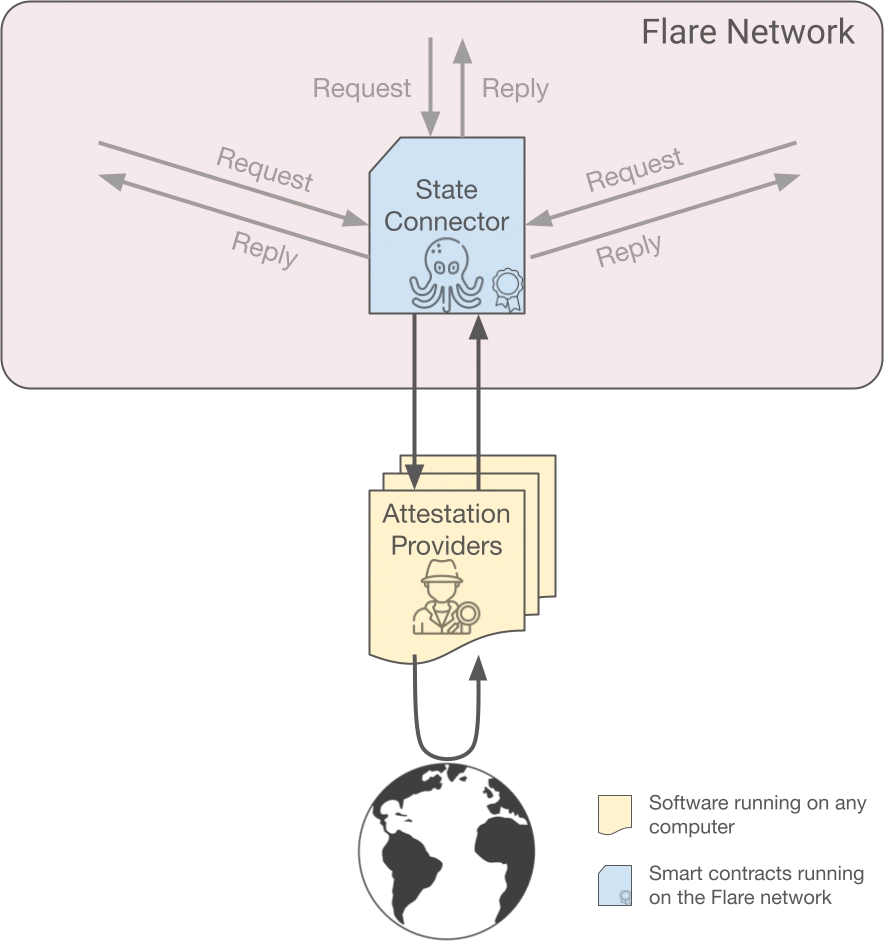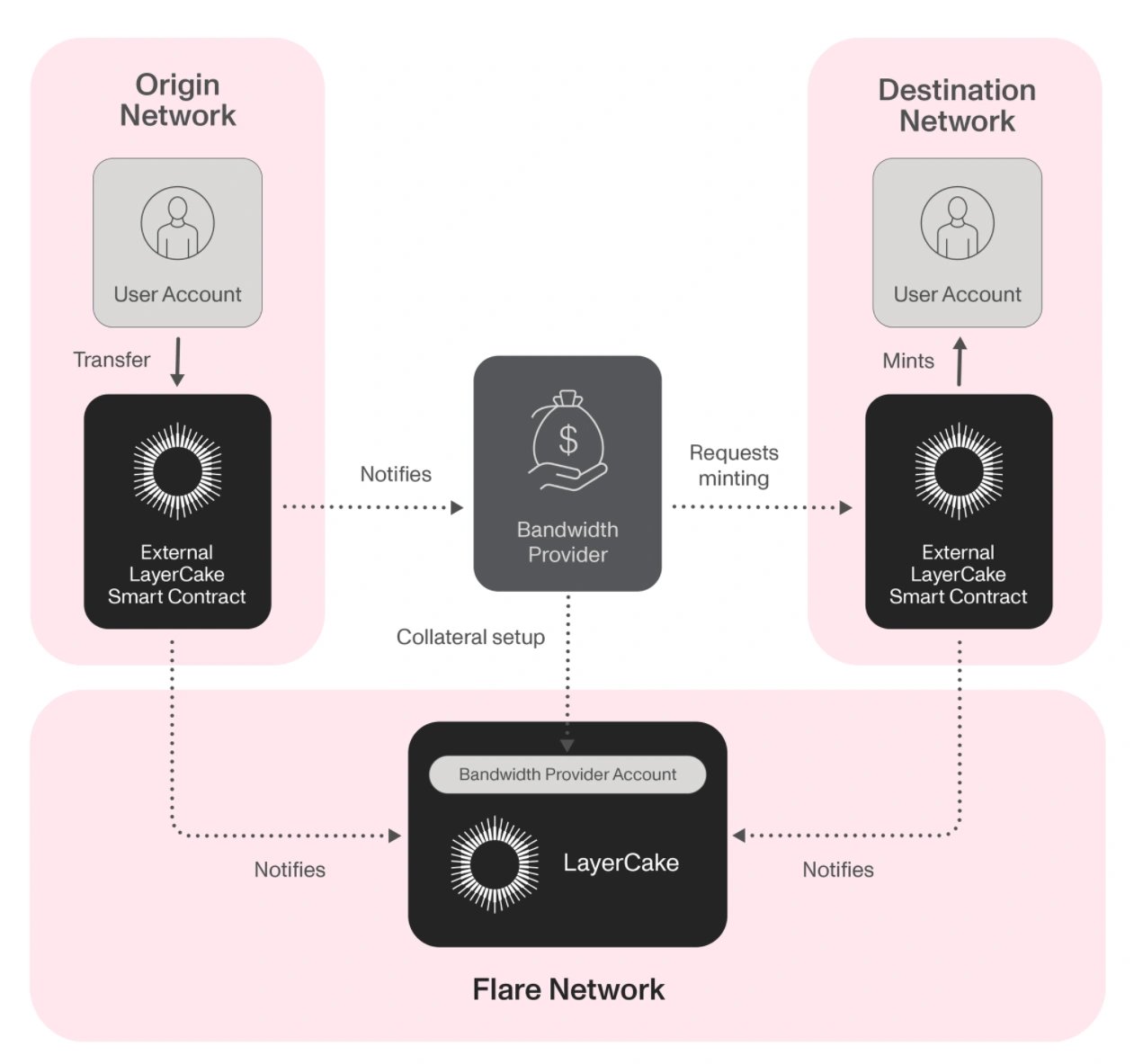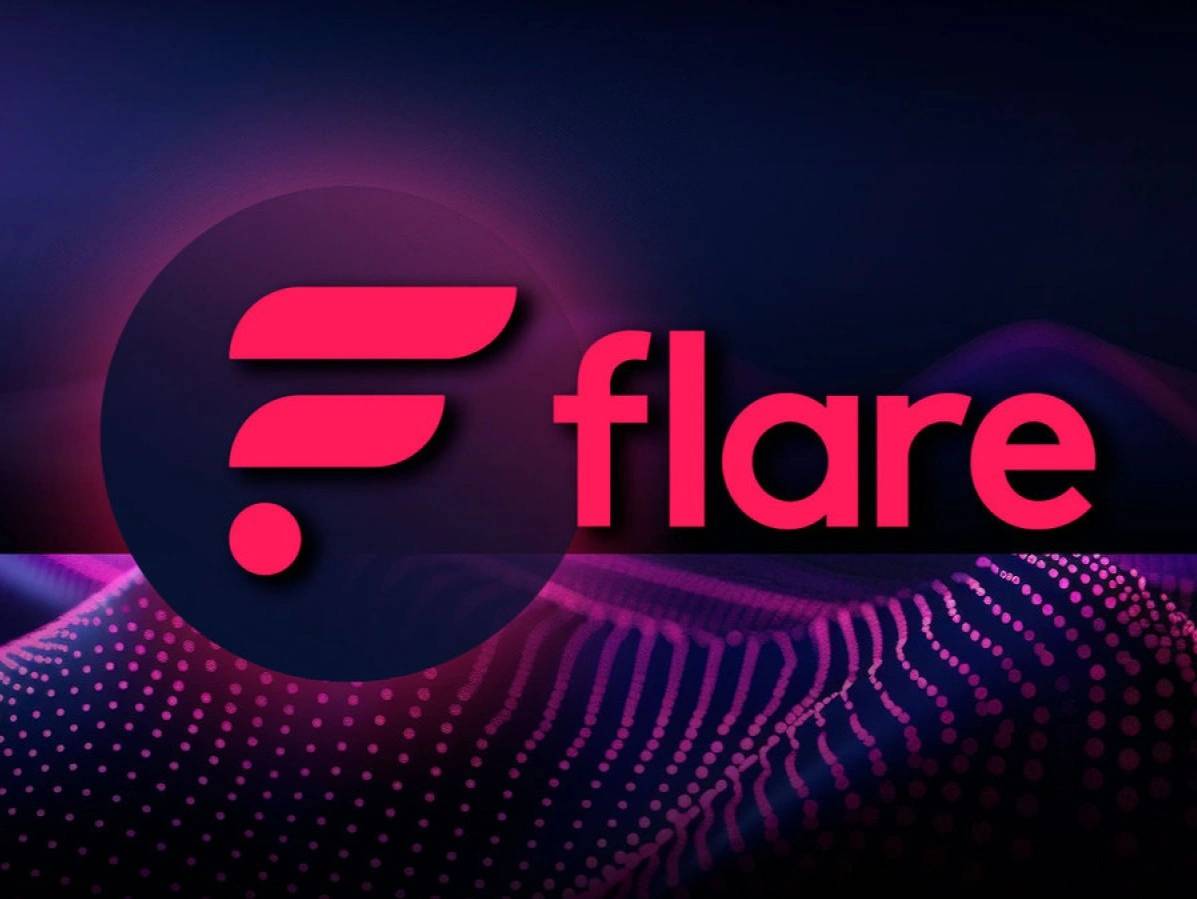위키 구독하기
Share wiki
Bookmark
Flare
Flare
Flare는 데이터 접근 및 관리에 중점을 둔 Layer 1 블록체인이며, Ethereum Virtual Machine (EVM) 스마트 계약 플랫폼을 활용합니다. 주요 목표는 중앙 통제 없이 보편적인 접근성을 보장하는 데이터 분산입니다. [1]
개요
2019년에 설립된 Flare는 블록체인 개발자를 위한 데이터 접근성을 향상시키도록 설계된 플랫폼입니다. 이 시스템은 검증자 및 데이터 소스 역할을 하는 인프라 제공업체에 의해 지원되며, 두 가지 주요 네이티브 오라클인 FTSO와 State Connector의 기능을 보장합니다. 이러한 오라클은 Flare 네트워크의 개발자를 위한 데이터 접근을 비용 효율적으로 단순화하는 데 중요한 역할을 합니다. 여기에는 Flare Labs에서 개발한 LayerCake도 포함되어 있는데, 이는 전송 중 보험이 포함된 분산형 브리징 및 크로스 네트워크 구성 가능성 프로토콜입니다.[2][1]
플레어 프로토콜
플레어 타임시리즈 오라클(FTSO)
플레어 네트워크 내의 FTSO는 다양한 데이터 유형에 대한 지속적이고, 분산되고, 안전한 추정치를 제공합니다. 독립적인 데이터 제공자는 다양한 소스에서 데이터를 가져오고, FTSO 시스템은 가중치가 부여된 입력을 기반으로 최종 추정치를 계산합니다. 원래 암호화폐 가격 쌍을 위해 설계되었지만, 현재 FTSO는 모든 데이터 유형을 지원합니다. 귀중한 기여를 제공하는 데이터 제공자는 보상을 받고, 결과 데이터 추정치는 사용을 위해 온체인에 게시됩니다. FTSO 워크플로우, 결과 계산, 투표 권한, 위임 및 개발자 상호 작용에 대한 지침을 포함한 주요 측면이 다루어집니다. [3]

절차
모든 Flare 네트워크 사용자는 FTSO 데이터 제공자 역할을 하고 데이터를 제출할 수 있습니다. 각 에포크 동안 시스템은 투표력이 가장 높은 상위 100명의 데이터 제공자로부터 제출된 데이터를 고려합니다. 데이터 제출은 지원되는 암호화폐의 현재 가격(USD)을 반영해야 합니다. 제출 과정은 라운드 단위로 진행되는 커밋-앤-리빌 메커니즘을 통해 개인 정보를 보호합니다. FTSO 시스템은 각 제공자의 투표력을 고려하여 중앙값을 계산합니다. 결과 데이터 추정치는 5개의 가격 에포크 동안 공개적으로 이용 가능합니다. 데이터 제공자와 위임자는 각 에포크에서 정확하게 일치하는 데이터 제출에 대해 보상을 받습니다. 누적된 보상은 해당 에포크 이후에 청구할 수 있습니다.[3]
결과
플레어 시계열 오라클(FTSO)에서는 데이터 제공업체로부터 제출된 모든 데이터를 사용하여 각 가격 쌍에 대한 단일 추정치를 계산합니다. 가격 에포크는 3분 동안 지속됩니다. 각 제출에는 데이터 제공업체의 투표 권한을 기반으로 가격과 가중치가 연결됩니다. 가격 에포크에 대한 결과 가격은 제출된 모든 가격의 가중 중앙값입니다. 상위 및 하위 25% 범위 내의 제출은 보상을 받지 않습니다. [3]
투표력
FTSO에서 데이터 제공자의 제출물은 래핑된 플레어 또는 송버드 토큰(WFLR 또는 WSGB) 보유량 및 위임된 양에 연결된 투표력에 따라 가중치가 부여됩니다. 공정한 영향력을 유지하기 위해, 개인의 영향력은 플레어와 송버드 모두에서 총 투표력의 2.5%로 상한선이 설정됩니다. 각 보상 에포크 동안, 데이터 제공자의 투표력을 캡처하는 스냅샷이 생성되며, 이는 후속 에포크에 대한 가중치를 정의합니다. 투표력 블록으로 알려진 이 스냅샷은 이전 에포크의 마지막 블록에서 무작위로 선택됩니다. 블록 생성 시간의 변화는 특정 블록 선택을 결정하며, 플레어의 경우 대략 마지막 50%의 블록, 송버드의 경우 대략 마지막 25%의 블록입니다. 정기적인 보상 에포크는 송버드의 경우 7일마다, 플레어의 경우 3.5일마다 반복되는 설정된 패턴을 따릅니다.[3]
상태 커넥터
플레어 네트워크의 기본 요소인 상태 커넥터는 외부 체인과 인터넷에서 검증 가능하고 불변하는 데이터에 안전하게 접근하는 메커니즘 역할을 합니다. 스마트 계약으로 작동하며, 사용자에게 이러한 유형의 데이터를 쿼리할 수 있는 기능을 제공합니다. 상태 커넥터는 독립적인 증명 제공자를 이용하여 정보를 검색하고 검증함으로써 분산되고 안전한 방식으로 작동합니다. 그런 다음 합의 프로세스를 통해 네트워크에서 데이터를 사용할 수 있게 됩니다.[4]

절차
주(州) 커넥터는 정확성과 개인 정보 보호에 중점을 두고 사용자 질의를 처리합니다. 사용자는 특정 이벤트를 확인하기 위해 질의를 시작하며, 이 질의는 가스 비용 최적화를 통해 증명 제공자에게 전송됩니다. 증명 제공자는 필요한 증명 유형에 따라 다양한 소스에서 데이터를 검색합니다. 답변은 기밀 "커밋 및 공개" 프로토콜을 통해 제출됩니다. 유효성은 증명 제공자 간 최소 50%의 합의에 의해 결정되며, 합의에 도달하지 못하면 재제출을 요청합니다. 주(州) 커넥터는 결과 답변을 스마트 계약 내에 일주일 동안 저장하여 사용자가 액세스할 수 있도록 합니다.[4]
증명 프로토콜
Flare는 효율적인 운영을 보장하기 위해 두 가지 중요한 프로토콜을 통합합니다. 첫째, 중첩 CCCR 프로토콜은 증명 라운드에서 요청 및 응답 처리를 간소화하여 라운드 간 지연을 최소화하는 것을 목표로 합니다. 둘째, 증명 패킹은 각 라운드에서 머클 트리를 사용하여 유효한 응답을 단일 해시로 통합합니다.[4]
분기 프로토콜
상태 커넥터는 분기 프로토콜을 통합하여 검증자 노드가 신뢰할 수 있는 증명 제공자 간의 의견 불일치 발생 시 실행을 중지하고 포크할 수 있도록 함으로써 보안을 강화합니다. 두 가지 중요한 제공자 집합이 정의됩니다. 모든 검증자가 의존하는 기본 집합과 운영자가 추가 신뢰 제공자를 지정할 수 있는 로컬 집합입니다. 성공적인 증명 라운드를 보장하려면 두 집합 모두에서 합의가 필요합니다. 포크 발생 시, 불일치가 로컬 제공자 집합에 있는지 또는 기본 제공자 집합에 있는지에 따라 해결 방법이 다릅니다. [4]
Layercake
Flare Labs에서 개발 중인 LayerCake는 전송 중 보험이 포함된 분산형 브리징 및 크로스 네트워크 합성 가능성 프로토콜입니다. 다양한 스마트 계약 네트워크 간의 브리징을 위한 향상된 보안, 속도, 확장성 및 기능을 강조합니다. 브리징 프로세스 내에서 간소화된 자동화된 작업을 가능하게 합니다. [5]

프로세스
LayerCake 프로세스는 실제 자산으로 1:1 비율로 담보된 담보를 사용하여 전송을 보장함으로써, 저지연 신뢰 없는 브리징을 보장합니다. 전송이 완료되면, 담보( "대역폭" 이라고 함)는 짧은 시간 후에 해제되며, 브리지에서 동시에 이동할 수 있는 값을 결정합니다. 대역폭 담보는 대역폭 제공자로 알려진 브리지 운영자가 제공하며, 각 거래에 대해 소액의 수수료를 부과합니다. 브리지의 총 대역폭은 동시 트래픽의 양을 결정합니다. LayerCake는 유동성 분열을 방지하기 위해 다자간 접근 방식을 사용합니다.[5]
플레어(FLR) 토큰
플레어 토큰 (FLR)(Flare token (FLR)), 이전에는 Spark로 알려졌던, 플레어 생태계 내의 인플레이션형 토큰입니다. 스마트 계약, 거래 수수료 및 FTSO에서 생성된 FLR 토큰에 사용됩니다. 일관된 사용 비용을 목표로 하여 DeFi(디파이), NFT(NFT), 메타버스(메타버스) 및 게임과 같은 다양한 애플리케이션을 가능하게 합니다.[6][7]
송버드(SGB) 토큰
캐너리 네트워크는 새로운 기능을 주 네트워크에 배포하기 전에 라이브 환경에서 테스트하는 데 사용되는 지정된 토큰 공급량을 가진 기능적인 블록체인이며, 무제한 토큰을 가진 테스트넷과는 다릅니다. 캐너리 네트워크의 사용자는 실제 사용자이며, 그 실험적인 특성을 인지하고 있습니다. 플레어의 캐너리 네트워크인 송버드는 플레어 거버넌스 시스템의 초기 단계를 나타냅니다. 주요 역할에는 플레어 기술 테스트, 개발자에게 라이브 테스트 환경 제공, 네트워크 거버넌스 구조에서 하위 입법 기관으로서의 기능 수행이 포함됩니다. 송버드의 SGB 토큰은 모든 FLR 수령인에게 일회성으로 배포되며, 특히 추가 체인 포함, 가격 책정 메커니즘, FTSO 및 FAsset 프로토콜 내 FAsset과 관련된 거버넌스 결정에 기여합니다. [19] [18]
Flare 베타
토큰 배포 이벤트와 동시 베타 단계 출시는 2023년 1월 9일에 진행되었습니다. 베타 단계 동안 Flare는 전문 인프라 제공업체 및 FTSO 참가자의 검증자를 포함하는 이중 검증 시스템을 구현했습니다. 이 구조는 Flare Foundation의 검증자 5명https://iq.wiki/wiki/validator, 전문 인프라 파트너의 검증자 15명, 그리고 최대 100명의 FTSO 검증자의 잠재적 참여로 구성됩니다. 이 단계는 인프라 파트너에서 FTSO 그룹으로의 검증 권한의 원활한 전환을 목표로 하며, 궁극적으로 독점적인 FTSO 검증자 운영으로 이어집니다. 인플레이션의 20%를 구성하는 검증자 보상은 인프라 파트너 검증자와 FTSO 검증자에게 균등하게 분배되었으며, Flare Foundation 검증자는 보상을 받지 않았습니다. 주요 인프라 제공업체는 네트워크 경제, 토큰 또는 위임에 영향을 미치지 않는 6~9개월 동안 지속될 것으로 예상되는 이 단계를 위해 Flare 검증자를 적극적으로 설정하고 있었습니다.[13]
FLR 토큰 소각
2023년 10월 13일, 플레어(Flare)는 21억 개의 FLR 토큰을 소각할 것이라고 발표했습니다. 이 조치는 2020년 12월 네트워크 스냅샷 당시 보유량을 유지한 XRP 보유자들에게 이루어진 이전 에어드롭에 따른 것입니다. FLR 총 공급량의 2%를 소각하기로 한 결정은 생태계의 건강과 개발을 향상시키기 위한 것입니다. 플레어의 초기 후원자들을 위해 원래 예약되었던 토큰들은 Flare Improvement Proposal, FIP.01에 대한 논의와 합의에 따라 최종적으로 소각되었습니다. 발표 당일 약 1억 9,800만 개의 FLR 토큰이 소각되었으며, FlareDrop 프로세스가 완료되는 2026년 1월까지 매달 6,600만 개의 토큰이 추가로 소각될 예정입니다. 약 2,000만 달러 상당의 이번 조치는 희석을 줄이고 새로운 사용자들이 네트워크에 참여하도록 유도하는 데 기여합니다. [15][16]
"주주들과 합의에 도달하게 되어 매우 기쁘게 생각하며, 그들의 지지에 감사드립니다. 투자자 토큰 할당량 또한 FIP.01에서 구현된 변경 사항의 영향을 받는 것이 마땅합니다. 이번 소각이 없었다면 투자자들은 FlareDrops를 통해 원래 할당량의 약 3배를 청구할 수 있었을 것이며, 이는 커뮤니티 보유량을 불공정하게 희석시켰을 것입니다." - Hugo Philion, 플레어 CEO & 공동 설립자
팀
- Hugo Philion: 공동 창립자 겸 CEO
- Sean Rowan: 공동 창립자 겸 최고 제품 책임자
- Naïri Usher 박사: 공동 창립자 겸 최고 과학 책임자
- Tim Bukher: 최고 운영 책임자 겸 최고 법률 책임자
- Jaime Abromovitz: 최고 성장 책임자
- Amaan Jalwa: 최고 재무 책임자
- Gabe Bassin: 최고 투자 책임자
- Josh Edwards: VP 엔지니어링[14]
업홀드(Uphold)와의 파트너십
2025년 5월 30일, 플레어 네트워크(Flare Networks)는 디지털 자산 거래 플랫폼인 업홀드(Uphold)와의 협력을 발표했습니다. 이는 플레어의 스마트 계약 인프라를 통해 XRP에 대한 수익 관련 기능을 탐색하기 위한 것입니다. 이 통합에는 플레어의 FAssets 시스템이 사용되는데, 이 시스템은 스마트 계약을 기본적으로 지원하지 않는 자산, 예를 들어 XRP와 같이 플레어 네트워크에서 자산을 표현할 수 있도록 합니다.
이 계획은 "XRPFi"라고 불리는 진행 중인 프로그램의 일부로, XRP에 탈중앙화 금융 (DeFi) 기능을 도입하기 위한 것입니다. 이러한 노력의 일환으로, 곧 출시될 FAssets 프로토콜의 메인넷 배포를 통해 사용자는 XRP와 같은 토큰의 스마트 계약 호환 표현을 생성할 수 있습니다.
발표 직후, 플레어의 네이티브 토큰(FLR)을 둘러싼 시장 활동은 거래량 증가와 가격 변동을 보였습니다. 관련 개발로, 플레어 네트워크의 공동 설립자 Hugo Philion은 기관과 협력하여 개발된 DeFi 플랫폼인 Firelight를 통해 XRP에 대한 스테이킹 모델을 도입할 의향을 밝혔습니다. 이 모델은 유동적 스테이킹 기능을 제공하여 보유자가 파생 토큰을 통해 유동성을 유지하면서 XRP를 스테이킹할 수 있도록 합니다.
플레어-업홀드 협업은 기존의 비프로그래밍 가능 자산을 탈중앙화 애플리케이션과 연결하려는 광범위한 노력의 일부입니다. 이러한 시스템의 배포는 XRP 생태계 내에서 수익 생성 도구에 대한 접근을 확장하는 수단으로 자리매김하고 있습니다. [20] [21] [22]
잘못된 내용이 있나요?
